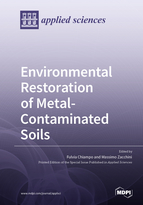Environmental Restoration of Metal-Contaminated Soils
A special issue of Applied Sciences (ISSN 2076-3417). This special issue belongs to the section "Environmental Sciences".
Deadline for manuscript submissions: closed (10 May 2021) | Viewed by 25789
Special Issue Editors
Interests: solid wastes; soil remediation; landfill gas; environmental impacts of industry
Special Issues, Collections and Topics in MDPI journals
Interests: phytoremediation; metal uptake and transport in plants; ecotoxicological assessment; phytomanagement; tissue culture
Special Issues, Collections and Topics in MDPI journals
Special Issue Information
The restoration of metals/metalloids polluted soils constitutes one the main environmental challenges of the present century, affecting mainly industrial sites.
Notwithstanding, huge attention is placed on the applied techniques and their removal efficiency. This issue requires a multidisciplinary approach due to its different features.
The deeper knowledge of advanced techniques, leading to high removal efficiency, must be combined with careful and reliable activities for in situ monitoring and with methodologies for quick and easy-to-use analysis of the process parameters. Conventional and nature-based technologies are particularly targeted when dealing with innovative solutions able to couple the global request for environmental sustainability to the remediation efficiency. The socioeconomic issues should have more than just minor relevance for the whole remediation project, both for the cost questions and for social involvements.
This Special Issue looks at actors that with different knowledge and expertise can bring a contribution to the solution of the multifaceted problem regarding especially industrial areas, addressing both laboratory trials and on field case studies.
Prof. Fulvia ChiampoDr. Massimo Zacchini
Guest Editors
Manuscript Submission Information
Manuscripts should be submitted online at www.mdpi.com by registering and logging in to this website. Once you are registered, click here to go to the submission form. Manuscripts can be submitted until the deadline. All submissions that pass pre-check are peer-reviewed. Accepted papers will be published continuously in the journal (as soon as accepted) and will be listed together on the special issue website. Research articles, review articles as well as short communications are invited. For planned papers, a title and short abstract (about 100 words) can be sent to the Editorial Office for announcement on this website.
Submitted manuscripts should not have been published previously, nor be under consideration for publication elsewhere (except conference proceedings papers). All manuscripts are thoroughly refereed through a single-blind peer-review process. A guide for authors and other relevant information for submission of manuscripts is available on the Instructions for Authors page. Applied Sciences is an international peer-reviewed open access semimonthly journal published by MDPI.
Please visit the Instructions for Authors page before submitting a manuscript. The Article Processing Charge (APC) for publication in this open access journal is 2400 CHF (Swiss Francs). Submitted papers should be well formatted and use good English. Authors may use MDPI's English editing service prior to publication or during author revisions.
Keywords
- remediation
- metals/metalloids
- pollution removal
- monitoring
- socioeconomic issues







